WILLIAM ROTHENSTEIN AND ALBERT RUTHERSTON (LOTS 1–23)

Raised in Bradford as two of six children of Jewish immigrants from North Germany, William and Albert enjoyed a close relationship, and during their lives achieved considerable influence and success at the very heart of the British art establishment. Amongst their many and remarkable strengths they were painters, printmakers, illustrators, teachers, administrators, gallerists and, in William’s case, an accomplished and prolific writer.
By dint of age, William was the first to move south to study under Alphonse Legros at the Slade (1888–89) before attending the Académie Julian in Paris (1889–1893) (lots 1–8), where he was encouraged by Whistler, Degas and Toulouse-Lautrec, befriended Rodin and briefly shared a studio with Charles Conder. Albert followed ten years later to the Slade, where by then Fred Brown was professor, assisted by English luminaries Henry Tonks, Philip Wilson Steer and Walter Russell. The youngest student by far, Albert fell in with a gilded set of like-minded spirits, in particular Augustus John and William Orpen. The young trio was dubbed by William ‘The Three Musketeers’. Albert went on to win separate prizes for both drawing and painting and was awarded a Slade scholarship.

On his return from France to England, William established himself as a talented portraitist illustrating Oxford Characters in 1896 with twenty-four lithographs. Sitters ranged from Viscount St. Cyres to Hilaire Belloc; it was one of several collections of portraits depicting men and women of distinction that William would produce. As with his time in Paris where he met some of the most influential artists of the day, so his portraits brought him into the company of those at the heart of the British establishment.
In 1900 William’s painting The Doll's House (after Ibsen’s eponymous play), won a silver medal at the Exposition Universelle in Paris. A moody interior of domestic strife, it was painted the same year as his book on Goya was published, the first in English. Such dark and foreboding influences, however, contrasted with the many happy and light-filled works he produced following his marriage to Alice Knewstub in 1899. Setting up home in Hampstead, Rothenstein regularly featured his young wife and their offspring in his subjects (lots 9 & 10).
2
William Rothenstein drawn by Emile Friant
Albert Rutherston
For Albert and his fellow ‘Musketeers’ the new century heralded the first of many holidays exploring and painting in France. On such trips he met Walter Sickert and shared holidays with William, Spencer Gore and Slade teacher Walter Russell. In London Albert thrived on Fitzroy Street and shared a separate space a few doors down to work and exhibit with William, Sickert, Gore, Russell and Harold Gilman. Open days were Saturdays, the combined aim as Sickert recalled being ‘to create a Salon d’automne milieu in London’.
Towards the end of the 1910s Albert turned increasingly to decorative designs working in watercolour and exploring painting on silk. In 1911 he collaborated with Roger Fry on large scale murals for Borough Polytechnic (lot 20) and after abandoning oils altogether in 1912 worked on a number of critically significant designs for the ballet and theatre (lots 14–16). In 1916 Albert changed his name to Rutherston, and the same year was posted to Egypt and Palestine. After the War he married actress Marjory Holman, and taught first at Camberwell School of Art, and then at the Oxford School of Drawing, Painting and Design, subsequently folded into the Ruskin School of Art, of which he was Master from 1929–49. A late but important influence in his life was the young model Patricia Koring whom he met in 1938. She inspired him to return to painting in oil and was his muse and model for the next twelve years.
From the First World War on William’s work revolved around his painting, high level teaching posts and writing. During 1917–18 he spent six months as an official artist of the British and Canadian armies at the Front (lot 12). The same year he was briefly visiting Professor of Civic Art at Sheffield University, and in 1920 was appointed Principal of the Royal College of Art in London. He was awarded a knighthood for services to the arts in 1931. As well as Goya, among William’s diverse publications were Wider use of Artists and Craftsmen (1916), Whither Painting fascinating volumes of memoirs: Men and Memories Since Fifty (1939). William’s two sons carved out their own highly influential paths in the Arts. John (1901–92) his eldest, became the longest serving director of the Tate Gallery (1938–1964), wrote the seminal Painters (1956) and was knighted in 1952. Michael (1908–1993) became a highly accomplished painter and print maker (lots 24–30).
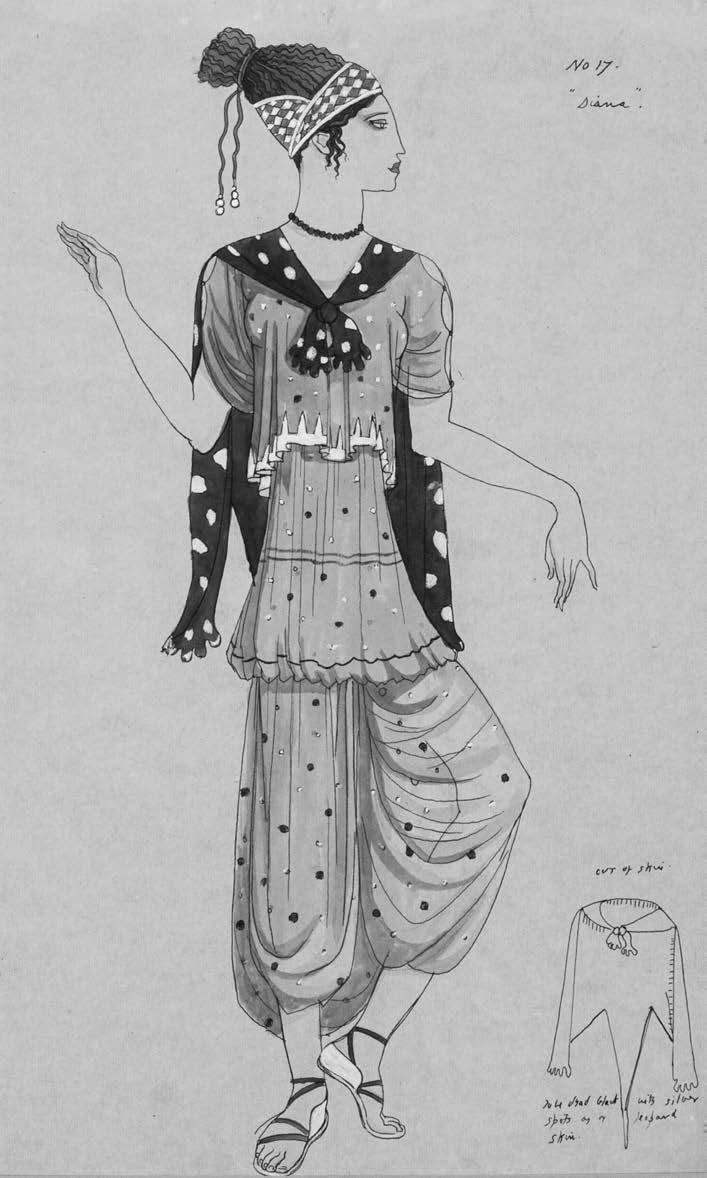
3
SIR WILLIAM ROTHENSTEIN (BRITISH 1872–1945)
PROFILE OF PAUL GERVAIS
inscribed P Gervais lower right charcoal with white chalk
36.5 x 23cm; 14¼ x 9in
Executed in Paris circa 1890. The painter Paul Gervais (1859–1944) was a teacher at the Académie Julian where Rothenstein studied from 1889–1893. A pupil of Jean Léon Gérôme, Gervais was known, and occasionally rebuked, for his depictions of sensuous nudes. Prominent commissions included Les Graces Florentines for La Salle Blanche in the Casino de Monte-Carlo and the Salle Empire in the Hôtel de Paris, Monte-Carlo.
£250–350
SIR WILLIAM ROTHENSTEIN (BRITISH 1872–1945)
STUDENT AT THE ACADEMIE JULIAN
charcoal with white chalk
36.5 x 23cm; 14¼ x 9in
Executed in Paris circa 1890.
£250–350
SIR WILLIAM ROTHENSTEIN (BRITISH 1872–1945)
THE LIFE CLASS, ACADEMIE JULIAN
inscribed stove, model, student lower right charcoal with white chalk
36 x 23cm; 14¼ x 9in
Executed in Paris circa 1890.
£150–250
SIR WILLIAM ROTHENSTEIN (BRITISH 1872–1945)
PHIL MAY WITH PIPE
inscribed Me when I’mould. [sic] lower right charcoal with white chalk
36 x 23cm; 14 x 9in
Executed circa 1890 whilst at the Académie Julian, Paris. The inscription on this sketch of the Australian caricaturist Phil May (1864–1903) is a typical jeu de mot by Rothenstein - a play on the words ‘me when I’m old’, but it could equally have been added by May himself. May was the leading cartoonist of his day and is depicted by Rothenstein with his distinctive fringe. The two artists briefly shared a studio on the Rue Ravignan in Montmartre.



£200–300

4 1 2 4 1
2
3
4
SIR WILLIAM ROTHENSTEIN (BRITISH 1872–1945) IN THE WINGS


charcoal with white chalk
36.5 x 23cm; 14¼ x 9in
Executed circa 1890 whilst a student at the Académie Julian, Paris.
£250–350
6
SIR WILLIAM ROTHENSTEIN (BRITISH 1872–1945) BY THE FIRE

charcoal and white chalk
37 x 23cm; 14½ x 9in
Execucuted circa 1890 whilst a student at the Académie Julian, Paris.
£200–300
7
SIR WILLIAM ROTHENSTEIN (BRITISH 1872–1945)
THE LAUNDRESS
charcoal and white chalk
36 x 23cm; 14¼ x 9in
Executed circa 1890 whilst a student at the Académie Julian, Paris.
£150–250
8
SIR WILLIAM ROTHENSTEIN (BRITISH 1872–1945) THE PAINSON AND THE PARTER (SELF-PORTRAIT)
titled THE PAINSON AND THE PARTER right
charcoal with white chalk
34.3 x 20.5cm; 13½ x 8in
51.5 x 36cm; 20¼ x 14¼in (framed)
Provenance
with Michael Parkin Fine Art Ltd, London.
With one head placed above the other, Rothenstein’s playful vertically descending title is a jeu de mot on ‘the painter and the parson’. Presenting himself chorister-like with mouth wide open, Rothenstein’s identity is clear, but less so that of the smiling parson beneath him, although it has been suggested that it could be a double self-portrait as Whistler’s nickname for Rothenstein was the parson due to his tendency to seriousness.
£150–250

8 7 6 5 5 5
SIR WILLIAM ROTHENSTEIN (BRITISH 1872–1945)
(I) NURSE AND CHILD; (II) FEEDING HENS; (III) ALICE WITH JOHN
(iii) signed and dedicated for John and Elizabeth affect. Albert lower left pastel
(i) 20 x 22.3cm; 8 x 8¾in
41 x 43cm; 16 x 17in (framed)
(ii) 23 x 32cm; 9 x 12½in
40.5 x 56cm; 16 x 22in (framed)
(iii) 34 x 23cm; 13¼ x 9in (unframed)
(3)
Provenance
(iii) John and Elizabeth Rothenstein, London (a gift from the artist).
Painted in the early 1900s, these three pastels all feature Rothenstein’s eldest child John: (i) John with his nurse; (ii) almost certainly John feeding hens with his mother, Rothenstein’s wife Alice and (iii) Alice giving John a piggyback.



Alice Rothenstein (1867–1957, née Knewstub) was the daughter of the artist John Knewstub and the pre-Raphaelite muse Emily Renshaw. She trained as an actress and married Rothenstein in 1899. Their first child John, born in 1901, went on to become Director of the Tate Gallery, and was knighted in 1952 for services to the arts. He and his mother feature in a number of notable paintings by Rothenstein, including the oil Mother and Child (Tate Britain) painted in 1903 when the Rothensteins were living on Church Row, Hampstead.
£150–250 10
SIR WILLIAM ROTHENSTEIN (BRITISH 1872–1945)
(I) HEAD OF A WOMAN; (II) ALICE IN PROFILE
(ii) signed with initials and dated 1916 lower right
(i) red chalk; (ii) pencil
(i) 32.5 x 26cm; 12¾ x 10¼in
55.5 x 48cm; 22 x 19in (framed)
(ii) 35 x 27.5cm; 13¾ x 10¾in
48 x 40cm; 19 x 15¾in (framed)
(2)
(ii) depicts the artist’s wife, Alice (née Knewstub); see note to previous lot.

£100–200
SIR WILLIAM ROTHENSTEIN (BRITISH 1872–1945)
(I) THE BANJO PLAYER; (II) STUDIES OF A DANCER (RECTO & VERSO); (III) SKETCH OF A YOUNG GIRL AND A SOLDIER’S HEAD



(i) charcoal; (ii) black crayon heightened with white & pencil heightened with white; (iii) black crayon heightened with white
each: 36 x 23cm; 14¼ x 9in
(3)
£150–250
11 (iii) 6 9
9 (iii) 11 (ii)
11
9 (ii)
10 (i) 10 (ii)
9 (i)
SIR WILLIAM ROTHENSTEIN (BRITISH 1872–1945)
BOMB DAMAGE TO THE SQUARE AND CATHEDRAL, PERONNE, THE SOMME
oil on canvas
76.5 x 101cm; 30 x 40in (unframed)
Exhibited
(probably), Sheffied, Mappin Art Gallery, On the Péronne Front, Paintings & Drawings by William Rothenstein, 1918.
Painted circa 1917–18. Rothenstein travelled to the Western Front as an Official War Artist in November 1917. Soon after his arrival he visited Péronne in the valley of the Somme. Of his impressions of the town he wrote: ‘The unwonted shapes of the ruined buildings, the pink flush of the red bricks, deepening to blood colour where the impact of a shell had made a wound in the walls, made a scene more tragic than any stagesetting.’ (William Rothenstein, Men and Memories, London, 1932, p. 326). An exhibition of paintings and drawings of his work at the Front was held at the Mappin Art Gallery, Sheffield University during June 1918, where the present oil was very likely exhibited. The subject in reverse was also reproduced as plate 4 in the set of twelve drypoints Rothenstein published in 1922 under the title Landscapes of the War. There is a painting of haystacks on the reverse of the present canvas.
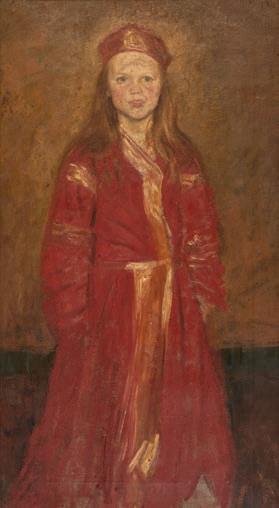

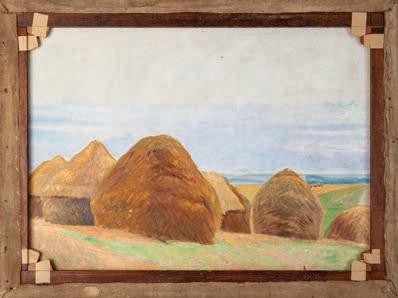
£2,000–3,000
13
SIR WILLIAM ROTHENSTEIN (BRITISH 1872–1945)
PORTRAIT OF RACHEL, THE ARTIST’S DAUGHTER
oil on canvas
81 x 46cm; 32 x 18in
91.5 x 56cm; 36 x 22in (framed)
Provenance
Rachel Ward (the sitter; a gift from the artist)
Exhibited
London, Max Rutherston, William Rothenstein, 1990, no.10.
£600–800
13 7 12
12 12 reverse
ALBERT RUTHERSTON (BRITISH 1881–1953)
COSTUME DESIGN FOR ‘DIANA’ IN LE REVEIL DE FLORE

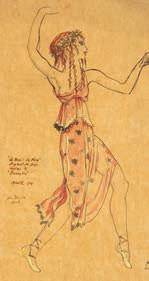
titled and numbered No 17./“Diana”. top right; inscribed cut of skin/to be dyed black with silver/spots on a leopard skin lower right pen and ink and watercolour heightened with silver paint
37 x 22.5cm; 14½ x 8¾in
61 x 48cm; 24 x 19in (framed)
Inscribed by the artist on a label on the reverse: Diana, “ Le Réveil de Flore”/P1b. “Sixteen Designs for the Theatre”/Albert RUTHERSTON.
Literature
Albert Rutherston, Sixteen Designs for the Theatre, London, 1928, pl. 16, illustrated. Executed in 1914; costume design for Diana in Le Reveil de Flore, the ballet abridged by Anna Pavlova and premiered in London on 12th October that year. Pavlova, former prima ballerina with the Russian Imperial Ballet, also toured the production to the USA, where it was performed at the Metropolitan Opera House in New York and in Chicago. Le Reveil de Flore, with music by Riccardo Drigo and choreographed by Marius Petipa, was first performed at the wedding of the Grand Duchess Xenia Alexandrovna, daughter of Tsar Alexander III on 6th August 1894. For a close variant of the present design see: Max Rutherston, Albert Rutherston, exhib. cat. London, 1988, pl. 7.
£1,000–1,500
15
ALBERT RUTHERSTON (BRITISH 1881–1953)
‘BACCHANTE’ IN LE REVEIL DE FLORE
signed, inscribed and dated Albert R 1914/‘Le Reveil de Flore’ fragment for first revisions of ‘Bacchantes’ and dedicated and dated For Patricia/1942 lower left watercolour over pen and ink
32.5 x 17cm; 12¾ x 6¾in
49.5 x 33cm; 19½ x 13in (framed)
Provenance
Patricia Koring (a gift from the artist in 1942).
See note to previous lot.
£400–600
16
ALBERT RUTHERSTON (BRITISH 1881–1953)
‘TIME’ IN THE WINTER’S TALE
titled ‘’Time’’. lower right
watercolour and gold paint over pen and ink and pencil on joined paper 41 x 23cm; 16 x 9in
Executed in 1911; costume design for Shakespeare’s The Winter’s Tale, produced by Harley Granville-Barker and performed at the Savoy Theatre in 1912. Granville-Barker’s production was heralded as one of the most important and innovative stagings of Shakespeare that century, breaking away from accepted Victorian canons of theatre.
£400–600

8 14 15 16 14
ALBERT RUTHERSTON (BRITISH 1881–1953)
SEATED NUDE WITH RAISED KNEE

pen and sepia ink and wash
38 x 27cm; 15 x 10½in
64 x 50cm; 25¼ x 19¾in (framed)
Almost certainly drawn when Rutherston was Ruskin Master of Drawing at Oxford University (1929–39).
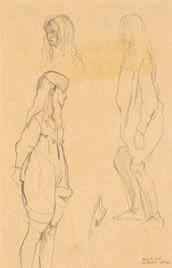

£500–700
18
ALBERT RUTHERSTON (BRITISH 1881–1953)
NUDE STUDY OF PATRICIA

signed and dated Albert R 1941 lower left pencil and crayon
20.5 x 16.5cm; 8 x 6.5in
58.5 x 43.5cm; 23 x 17¼in (framed)
Rutherston’s introduction to Patricia Koring in 1938 by the artist and designer Barnett Freedman inspired him to return to oil painting. Koring became Rutherston’s model and muse for the next decade.
£400–600
19
ALBERT RUTHERSTON (BRITISH 1881–1953)
PATRICIA
signed and dated Albert R. 1941. lower left pen and ink with watercolour
23 x 16.5cm; 9 x 6½in
59 x 44cm; 23¼ x 17¼in (framed)
See note to previous lot.
£300–500
20
ALBERT RUTHERSTON (BRITISH 1881–1953)
STUDIES OF A YOUNG GIRL
signed and dated Albert R 1911 and dedicated For Patricia - Oct 46 lower right pencil
34 x 21.5cm; 13½ x 8½ in
51.5 x 37cm; 20¼ x 14½in (framed)
Provenance
Patricia Koring (a gift from the artist).
Study of a young girl hitching up her dress for Paddling in the Serpentine, a mural of children bathing painted by Rutherston for the dining room of Borough Polytechnic. Other scenes were painted by Duncan Grant, Frederick Etchells, Bernard Adeney and Macdonald Gill. The finished large scale works are now in Tate Britain.
£200–400
9 17 18 19 20 17
ALBERT RUTHERSTON (BRITISH 1881–1953)
BATHERS


pen and ink and watercolour
26 x 17cm; 10¼ x 6¾in
£300–500
22
ALBERT RUTHERSTON (BRITISH 1881–1953)
A SOUTHERN LANDSCAPE
signed and dated Albert R.1914 lower right gouache

25 x 35cm; 9¾ x 13¾in
51 x 64cm; 20 x 25in (framed)
Probably painted at Grasse in Provence, South of France.
£450–650
23
ALBERT RUTHERSTON (BRITISH 1881–1953)
THE SANDCASTLE BUILDERS - (I) & (II)
(ii) signed and dated Albert R 32 lower right both: pastel over pencil
(i) 31 x 24.5cm; 12¼ x 9½in
(2)
Depicted are Rutherston’s wife Marjory (née Holman), an actress whom Rutherston married in 1919, with their two sons David and Michael.
£200–300

10
21 22
23 (i)
21
23 (ii)
MICHAEL ROTHENSTEIN (LOTS 24–30)

Michael Rothenstein was born in Hampstead where he grew up on Church Row, the youngest child and second son of William and Alice Rothenstein (lots 1–13). He studied painting at Chelsea Polytechnic and the Central School of Arts and Crafts (1924–27), and had an early solo exhibition at the Warren Gallery on Maddox Street, London W1 in 1931. His fluid youthful style is reflected in such faintly satirical works as Making Hay (lot 24).
Rothenstein suffered from bouts of depression, but towards the end of the ‘thirties painted a series of bravura landscapes (lots 25–28) a selection of which he exhibited at the Matthiesen Gallery in 1938. After War broke out, his careful observation of the English countryside made him well suited to participating in the Pilgrim Trust Recording Britain project set up by Sir Kenneth Clark. But thereafter increasingly Rothenstein turned to print making.
Among his early successful prints was Timber Felling (1945), which he made for the School Prints Series to give children an understanding of contemporary art. He also made drawings for the War Artists Committee. And he visited S W Hayter’s Atelier 17 in Paris, returning to England to make colour etchings. In 1954 he moved to Great Bardfield in Essex, home to a thriving coterie of artists, amongst them Edward Bawden and Kenneth Rountree, where he set up a graphic workshop while also teaching at Camberwell School of Art and Stoke-on-Trent College of Art. (lots 29 & 30).
During the 1950s and ‘60s Rothenstein burnished his reputation as one of the most experimental print makers in Britain. Accolades included winning the Giles Bequest Competition for colour woodcuts and linocuts in 1954 and 1956. He lectured extensively, wrote several books on the subject, amongst them Frontiers of Printmaking (1966), and was instrumental in the formation of the Printmakers Council, serving as its first chairman. In 1977 he was voted ARA, and in 1984 RA.
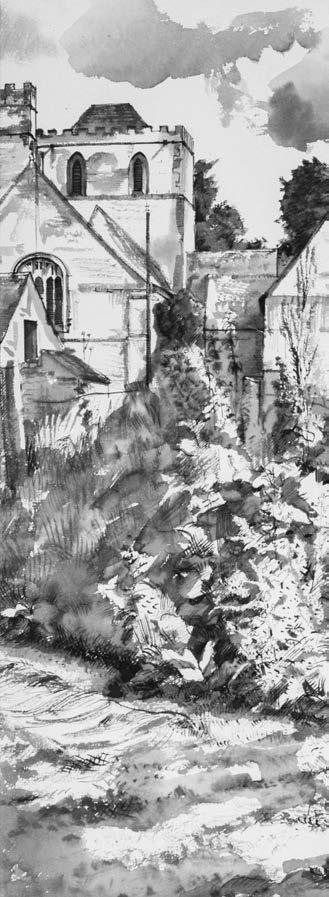
11
MICHAEL ROTHENSTEIN (BRITISH 1908–1993)
MAKING HAY
signed and dated Michael Rothenstein 1931 upper left gouache
65 x 60cm; 25½ x 23¾in
80 x 76 cm; 31½ x 30in (framed)
£600–800 ARR may apply
25
MICHAEL ROTHENSTEIN (BRITISH 1908–1993)
NEAR STROUD
signed and dated M. Rothenstein 1939. lower right pen and brush and sepia ink
39 x 55.5cm; 15¼ x 22in
59.5 x 75cm; 23½ x 29½in (framed)

Provenance with Abbott & Holder, London
Rothenstein had a troubled childhood marked by long bouts of depression, but marked his emergence from the malady in the late 1930s with a series of astounding large scale and detailed drawings in ink which include the present work and lot 26. Mostly inspired by the Cotswolds where he grew up, these examples presage his drawings completed the following year for the Recording Britain project commissioned by the Ministry of Labour from a rosta of leading artists of the day.
£800–1,200 ARR may apply
26
MICHAEL ROTHENSTEIN (BRITISH 1908–1993)
GLOUCESTERSHIRE CHURCHYARD
signed and dated M. Rothenstein. 1939. upper left pen and ink and sepia wash


47 x 57.5cm; 18½ x 22¾in
67.5 x 77cm; 26½ x 30¼in (framed)
Provenance with Abbott and Holder, London.
£700–1,000 ARR may apply
24 12 24
25 26
MICHAEL ROTHENSTEIN (BRITISH 1908–1993)
COTSWOLD LANDSCAPE
signed M. Rothenstein upper left pen and ink and watercolour and wash
41.5 x 58.5cm; 16¾ x 23in
66 x 83cm; 26 x 32½in (framed)
£700–1,000 ARR may apply
28
MICHAEL ROTHENSTEIN (BRITISH 1908–1993)
FARM BUILDINGS

signed and dated M.Rothenstein.35 lower right brush and sepia ink
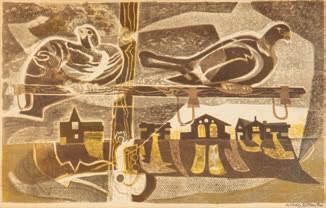
38.5 x 56cm; 15¼ x 22in
56 x 71cm; 22 x 28in (framed)
£300–500 ARR may apply 29
MICHAEL ROTHENSTEIN (BRITISH 1908–1993)
DOVES ON THE TELEGRAPH POLE
signed Michael Rothenstein lower right margin
lithograph, printed in colours
46 x 73cm; 18 x 28¾in
69.5 x 95.5cm; 27¼ x 37½in (framed)
Provenance
Redfern Gallery, London
Mrs Rachel Ward (née Rothenstein; 1903–1989), Bakewill, Derbyshire (by 1951).
£250–350 ARR may apply 30
MICHAEL ROTHENSTEIN (BRITISH 1908–1993)

ROOSTER ON THE TELEGRAPH POLE
printed signature (lower left)
lithograph, printed in colours
47 x 74cm; 18½ x 29in
69 x 95cm; 27 x 37½in (framed)
Provenance
Mrs Rachel Ward (née Rothenstein; 1903–1989), Bakewell, Derbyshire (a gift from the artist, her younger brother).
£250–350 ARR may apply

13 27
30 29 28 27
HEDWIG PILLITZ (LOTS 31–39)
We know frustratingly little of the talented Hedwig Pillitz who excelled as a portraitist, particularly portraits of those in the arts, notably leading actors and musicians. Born in Hampstead, Hedwig was the daughter of Arpad Armin Pillitz (1867–1948), and Josephine Fischer (b. 1876) who had emigrated to England from Hungary. Both she and her sister Doris attended South Hampstead High School for girls. There Hedwig excelled at art and Doris in music and drama.
The sisters’ considerable accomplishments are mentioned in the 1926 South Hampstead High School Magazine Jubilee Number where they are listed as members of the school’s Past and Present Club. Doris was praised for her musical contribution at the Old Girls’ Dinner in July that year, and the ‘Art’ report records that Hedwig had exhibited a landscape in the 1926 Paris Salon. Elsewhere, under the heading ‘Recent News’ it was noted that Hedwig was showing a flower piece and a landscape at the Autumn Exhibition at the Walker Gallery, Liverpool and that Doris had gained a First Class degree in acting at the Central School of Speech Training and Dramatic Art; was the winner of the second year students’ Diction Competition, and had been awarded a prize for verse recital at the 1926 Oxford Recitations.
A year on Doris is a cast member in the 1927–28 season at the Old Vic, performing in Hamlet, The Merchant of Venice, King Lear, Romeo and Juliet, and The Two Noble Kinsmen. It may well have been through Doris that Hedwig met ‘Yorkie’, also an actor at the Old Vic, whose portrait she painted whilst living at 28 Abercorn Place, St John’s Wood (lot 39), and at which address she also painted the dashing Michael Lane (lot 35). Hedwig attracted notable female sitters too as the lots in the present sale attest. Among them, the striking Marguerite Kelsey, a professional model in considerable demand among painters of the day (lot 31), and Russian born Shulamith Shafir, a distinguished concert pianist who made her English concerto debut in 1936 aged just thirteen, and first appeared at the Royal Albert Hall in 1941 (lot 33).
With many of Pillitz’s sitters being artists and performers, it is not surprising perhaps to find that of her few paintings in public collections, the best is also of an actor: Dorothy Black in the role of Emily Brontë in The Brontes (Victoria & Albert Museum). Hedwig painted Black in the lead role in 1933, the year that the play, written by Alfred Sangster, transferred from Sheffield to the Royalty Theatre, London. All Hedwig’s paintings in the present sale seem to have been painted from the late 1920s through until the 1950s.

14
HEDWIG PILLITZ (BRITISH - HUNGARIAN 1896–1987)
PORTRAIT OF MARGUERITE KELSEY
oil on canvas
62.3 x 49.5cm; 24½ x 19½in (unframed)
With her high cheek bones, fine features and cropped-back hair set off by her striking lime-green necklace, plunging neck line and viridian dress, Pillitz captures Kelsey with the contemporary poise and elegance for which she became noted. Kelsey started modelling at the age of fifteen and quickly became popular amongst artists for her ability to hold poses for a long time. The best-known likeness of her is by Meredith Frampton of 1928 in Tate Britain. Sitting upright on a settee with her legs behind, her gaze averted and wearing a white dress with red shoes she is the epitome of contemporary chic. Kelsey also sat for Sir William Reid Dick, Sir John Lavery, Augustus John and Dame Ethel Walker amongst many other painters of the day.
£350–550 ARR may apply 32
HEDWIG PILLITZ (BRITISH - HUNGARIAN 1896–1987)
PORTRAIT OF VERA PANTRA

oil on canvas
72.5 x 49cm; 28½ x 19¼in (unframed)
The sitter is believed to have been an actress.

£300–500 ARR may apply
33
HEDWIG PILLITZ (BRITISH - HUNGARIAN 1896–1987)

PORTRAIT OF SHULAMITH SHAFIR
oil on canvas
41 x 31cm; 16¼ x 12½in (unframed)
Shulamith Shafir (1923–2000) was an experienced pianist by age 16, known for bringing compositions by Beethoven and Chopin to performance level in days. During the Second World War she performed for the armed services and at a Dame Myra Hess concert. Shafir’s family moved to London in 1935, where she studied under George Woodhouse,and Solomon Cutner, both of whom influenced her later work. Notable recitals by Shafir include a Thanksgiving concert at the Royal Albert Hall in 1944 where she performed Sir Arthur Bliss’s Piano Concerto in B flat, and a Proms night in 1957 performing Liszt’s Hungarian Fantasia.
£120–180 ARR may apply
15 31 32 33 31
HEDWIG PILLITZ (BRITISH - HUNGARIAN 1896–1987)
FATA MORGANA
signed PILLITZ lower right; titled FATA MORGANA on the reverse oil on canvas
51 x 41cm; 20.1 x 16.2in
62.5 52.5; 24.5 x 20.5in (framed)
£300–500 ARR may apply
35
HEDWIG PILLITZ (BRITISH - HUNGARIAN 1896–1987)
PORTRAIT OF MICHAEL LANE
signed PILLITZ lower right oil on panel
40.5 x 30.5 cm; 16 x 12in
49.5 x 39.5 cm; 19½ x 15½in (framed)
Inscribed SKETCH/MICHAEL LANE/BY H E PILLITZ/29 ABERCORN PLACE/N.W.8 by another hand on the reverse.
£120–180 ARR may apply
36
HEDWIG PILLITZ (BRITISH - HUNGARIAN 1896–1987)


PORTRAIT OF PADDY GOODMAN VINE oil on canvas

76.5 x 63.5cm; 30¼ x 25in (unframed)
£300–500 ARR may apply
34
16
36
34 35
HEDWIG PILLITZ (BRITISH - HUNGARIAN 1896–1987)
PORTRAIT OF MISS LINDY CROOKER
oil on canvas
61 x 51cm; 24 x 20in (unframed)
£200–300 ARR may apply
38
HEDWIG PILLITZ (BRITISH - HUNGARIAN 1896–1987) STILL LIFE WITH IRISES

oil on canvas
74 x 51cm; 29 x 20in (unframed)
£100–150 ARR may apply
39
HEDWIG PILLITZ (BRITISH - HUNGARIAN 1896–1987)


‘YORKY’
signed PILLITZ lower left
oil on panel
36 x 26cm; 14 x 10¼in
51 x 41cm; 16¼ x 20in (framed)
Inscribed QUICK SKETCH OF ‘YORKY’ H.E.PILLITZ/28 ABERCORN PLACE/LONDON, N.W.8 by another hand on the reverse.
The sitter was an actor at the Old Vic theatre in London where Doris Pillitz, the artist’s sister, performed in a series of Shakespeare’s plays in 1926–27. It may well have been through Doris that Hedwig was introduced to the sitter (see intro).
£120–180 ARR may apply
37
17 37 38 39
HANS FEIBUSCH (LOTS 40–65)
To stand before an empty wall as in a trance… to let shapes cloudily emerge, to draw scenes and figures, to let light and dark rush out of the surface, to make them move outward or recede into the depths, this was bliss.
The son of a Frankfurt dentist, Feibusch had fought for the Kaiser in the First World War, emerged alive from the Russian Front, and had studied with Carl Hofer in Berlin and with fauve painter Emil Othon Friesz and cubist André Lhote in Paris. Come the 1930s he had a dealer in Berlin, had exhibited widely, and been awarded the German Grand State Prize for painting by the Prussian Academy of Arts. But Hitler’s rise to power threatened it all. In a meeting of the Frankfurter Künstlerbund which he attended in 1933, a new member appeared in Nazi uniform, jumped on a table and pointing at the Jews with his riding crop said: ‘You’ll never show again’. It was the moment Feibusch determined to emigrate.


Arriving in London he had his first one-man exhibition at the Lefevre Gallery, and was soon a member of the London Group. Further exhibitions with Lefevre followed; then in 1938 he completed his first large scale mural: Footwashing in the Methodist Chapel, Colliers Wood. It was a commission that would result in Feibusch becoming the leading muralist in Britain. Working both for the Church of England and local municipalities, over the next thirty-five years he decorated some forty plus churches and a range of civic buildings and private houses across England and Wales. His work contributed hugely to the re-generation of public buildings after the War and the debate on art in public places. But it also took him away from the Mayfair-centric contemporary art world. After his last exhibition at the Lefevre Gallery in 1951 he didn’t have another commercial show until the late 1970s.
Instead Feibusch threw himself into large scale mural projects, designing the decorations for the tea room at the Victoria & Albert Museum in 1946 (lots 52–54), and championed by George Bell, Bishop of Chichester, decorated bomb-damaged churches that were being re-built. These included painting the Ascension above the altar at All Saints, Plumstead (lot 62); Angels with Children for the baptistry of Christ Church and St Stephen’s, Battersea (lot 60) and the Baptism of Christ for Old Saint George’s Baptist Church, Plymouth (lots 61). Feibusch also wrote Mural Painting a treatise on the history, theory and technique of the art in 1946.
Exhibition Reference: The full details of the travelling exhibition abbreviated in lots 40-65 is: Chichester, Pallant House Gallery; London, Ben Uri Art Gallery; Northampton, Museum and Art Gallery; Eastbourne, Towner Art Gallery; Newport, Museum & Art Gallery, Hans Feibusch, The Heat of Vision, 1995–96
18
HANS FEIBUSCH (GERMAN-BRITISH 1898–1998)
PORTRAIT OF LUTZ FEIBUSCH

signed and dated H Feibusch/1917 lower right
red chalk
41 x 31cm; 16 x 12¼in
46.5 x 36.5cm; 18¼ x 14¼in (framed)
Lutz Feibusch, the artist’s brother, was tragically killed in an avalanche while skiing in 1929.
£100–150 ARR may apply
41
HANS FEIBUSCH (GERMAN-BRITISH 1898–1998)
SEATED DRAPED FIGURE

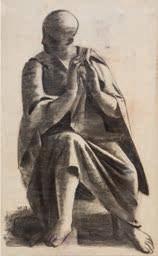
signed with initials and dated 37 lower left
charcoal
59.5cm x 36.5cm; 23½in x 14¼in
80cm x 55.5cm; 31½in x 21¾in (framed)
Exhibited
Hans Feibusch, The Heat of Vision, 1995–96, no. 10, illustrated in the catalogue.
£300–500 ARR may apply
42
HANS FEIBUSCH (GERMAN-BRITISH 1898–1998)
DIANA AND ACTAEON
chalk and pastel
45.5cm x 61cm; 18in x 24in
65.5cm x 79.5cm; 27¼in x 31¼in (framed)
Executed circa 1934
Exhibited
Hans Feibusch, The Heat of Vision, 1995–96, no. 7, illustrated in the catalogue.
£400–600 ARR may apply
43
HANS FEIBUSCH (GERMAN-BRITISH 1898–1998)

THE DREAM
signed with the initials and dated 39 lower right
black and white chalks
48 x 63cm; 19 x 24¾in (unframed)
There is a sketch of the same subject on the reverse.
£500–700 ARR may apply
40
19 40 41 42 43
HANS FEIBUSCH (GERMAN-BRITISH 1898–1998)
(I) STUDY OF A MANDRILL; (II) MANDRILLS AND MONKEYS
(i) pencil and black chalk; (ii) pencil
(i) 15.5 x 13cm; 6 x 5in
35 x 31cm; 13¾ x 12¼in (framed)
(ii) 26 x 17cm; 10¼ x 6¾in
45.5 x 35.5cm; 18 x 14in (framed)
(2)
Exhibited
Hans Feibusch, The Heat of Vision, 1995–96, nos. 20 & 21, illustrated in the catalogue Executed circa 1938, these sketches relate to Feibusch's ‘School Prints’ series (see following lot).


£300–500 ARR may apply
45
HANS FEIBUSCH (GERMAN-BRITISH 1898–1998)
MANDRILL AND MANGABEYS
coloured lithograph

47.5 x 74cm; 18¾ x 29in
51.5 x 78cm; 20¼ x 30¾in (framed)
Printed in 1947 at the Baynard Press, the composition derives from a series of sketches completed by Feibusch in 1938 (see: previous lot, and Hans Feibusch, The Heat of Vision, p. 58). Feibusch was one of some 30 contemporay artists commissioned by Brenda and Derek Rawnsley after the War to create lithographs for schools across the UK.
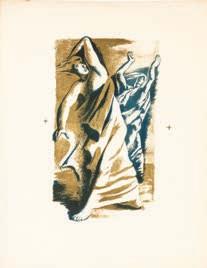
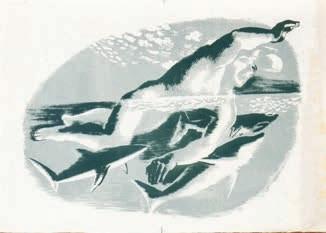
£150–250 ARR may apply
46
HANS FEIBUSCH (GERMAN-BRITISH 1898–1998)
(I) THE SWIMMER; (II) MOTHER AND DROWNING CHILD
(ii) signed and dated Hans Feibusch 1935 lower right both: lithograph
(i) 37cm x 52cm; 14½in x 20½in (unframed)
(ii) 33cm x 48.5cm; 13in x 19in; 49cm x 64.5cm; 19¼in x 25¼in (framed)
Both executed in the 1930s.
£200–300 ARR may apply
47
HANS FEIBUSCH (GERMAN-BRITISH 1898–1998)
(I) ADAM AND EVE; (II) ELIJAH; (III) THE STORM each: lithograph

(i) 40 x 26cm; 15¾ x 10¼in; (ii) 43 x 26.5cm; 17 x 10½in; (iii) 40 x 23cm;
15¾ x 9in (all unframed)
(3)
Each executed in the mid-1930s.
£150–250 ARR may apply
44
20 44 (i) 45 46 (i) 47 (i) 44 (ii) 47 (ii)
HANS FEIBUSCH (GERMAN-BRITISH 1898–1998)
SELF-PORTRAIT, HEAD AND SHOULDERS
signed with initials and dated 1932 lower right
brush, pen and ink and black chalk
27.5 x 22cm; 10¾ x 8¾in
43 x 36.5cm; 17 x 14¼in (framed)
Exhibited
Hans Feibusch, The Heat of Vision, 1995-96, no. 16, illustrated in the catalogue.
£80–120 ARR may apply
49
HANS FEIBUSCH (GERMAN-BRITISH 1898–1998)
AFTER THE BLITZ, THE OLD BAILEY BEYOND
pencil
23 x 35.5cm; 9 x 14in (unframed)

£300–500 ARR may apply
50
HANS FEIBUSCH (GERMAN-BRITISH 1898–1998)
LONDON, AFTER THE BLITZ

pencil
21.5 x 35cm; 8½ x 13¾in (unframed)
£200–300 ARR may apply
51
HANS FEIBUSCH (GERMAN-BRITISH 1898–1998)

LATONA AND THE FROGS
black and white chalks
71 x 49cm; 28 x 19¼in (unframed)
Executed circa 1934. There is a sketch of a standing woman with a frog on the reverse. The subject derives from the ancient story of the Goddess Latona turning the Lycian peasants into frogs after they prevented her from bathing and feeding her children, Artemis and Apollo, in a spring. For the related pastel see: Hans Feibusch, The Heat of Vision, 1995–96, pl. 3.
£200–300 ARR may apply

48
21 48 49 50 51
HANS FEIBUSCH (GERMAN-BRITISH 1898–1998)
CIRCUS SCENE WITH CLOWNS, ELEPHANTS AND HORSES

gouache
23.3 x 54cm; 9 1/4 x 21¼in
40 x 70.5cm; 15¾ x 27¾in (framed)
Executed in 1946, the present work is a preliminary design for the decoration of the tea room at the Victoria & Albert Museum for the post-War rallying exhibition Britain Can Make It held the same year.
£400–600 ARR may apply
53
HANS FEIBUSCH (GERMAN-BRITISH 1898–1998)
CIRCUS SCENE WITH TIGER AND LION
gouache
24 x 29cm; 9½ x 11½in
40.5 x 45.5cm; 16 x 18in (framed)
See note to previous lot.
£200–300 ARR may apply
54
HANS FEIBUSCH (GERMAN-BRITISH 1898–1998)
GIRAFFE

gouache on card
38 x 25cm; 15 x 9¾in (unframed)
£200–300 ARR may apply
55
HANS FEIBUSCH (GERMAN-BRITISH 1898–1998)
STUDY FOR A POSTER FOR THE ROYAL ACADEMY EXHIBITIONRECTO ;
RECLINING FIGURE IN COSTUME - VERSO
gouache and pen and ink - recto; gouache - verso
22.5 x 31cm; 8¾ x 12¼in (unframed)

Painted in 1938; a preliminary design for the Royal Academy Summer Exhibition that year designed for the London Underground; see Hans Feibusch, The Heat of Vision, 1995–96, p. 11 for the printed poster.
£300–500 ARR may apply

52
22 52 53 54 55
HANS FEIBUSCH (GERMAN-BRITISH 1898–1998)
THE FOUR SEASONS: STUDY FOR SUMMER - RECTO; RECLINGING FEMALE NUDE IN WOODLAND - VERSO


signed with initials HF dated 68 lower right - recto
gouache and watercolour
53 x 103cm; 21 x 40½in (unframed)

Executed in 1968; the verso is possibly a study for Autumn; see Hans Feibusch, The Heat of Vision, 1995–96, nos. 59 (Autumn) & 60 (Summer) for the related works.
£500–700 ARR may apply
57
HANS FEIBUSCH (GERMAN-BRITISH 1898–1998)
TWO VIEWS OF CLASSICAL RUINS IN THE HILLS, TAORMINA, SICILY
the first annotated with colour notes mountains slightly darker to margin lower right

gouache
(i) 26.5 x 53cm; 10½ x 21in; (ii) 28.5 x 53cm; 11¼ x 21in (both unframed)
(2)
£350–450 ARR may apply
58
HANS FEIBUSCH (GERMAN-BRITISH 1898–1998)
TWO ITALIAN LANDSCAPES
(I) PATH THROUGH A GARDEN; (II) AN OLIVE GROVE
both: gouache
both: 38.5 x 53cm; 15¼ x 21in (unframed)
(2)
£300–500 ARR may apply
59
HANS FEIBUSCH (GERMAN-BRITISH 1898–1998)
STILL LIFE OF LILIES AND ROSES WITH FRUIT, SCULPTURE AND FAUN

signed with initials and dated 90 lower right
pastel and black crayon
48cm x 63cm; 19 x 24¾in
61cm x 75cm x 24 x 29½in (framed)
£400–600 ARR may apply
56
23 56 (recto) 57 58 (i) 59 56 (verso)
HANS FEIBUSCH (GERMAN-BRITISH 1898–1998)
ANGELS WITH CHILDREN
signed with initials and dated 59 lower right gouache on card squared up
35.5 x 61cm; 14 x 24in (unframed)
A preparatory study for a mural for the baptistry at Christ Church and St Stephen, Battersea, London SW11. The previous year he had painted The Last Judgement on the east wall of the same church; see Hans Feibusch, The Heat of Vision, 1995-96, p. 25, M28, the mural listed.
£400–600 ARR may apply
61
HANS FEIBUSCH (GERMAN-BRITISH 1898–1998)
BAPTISM OF CHRIST

signed with initials and dated 60 lower left gouache on card
48 x 43cm; 19 x 17in (unframed)
A preparatory study for the mural over the altar for Old Saint George’s Baptist Church, Catherine Street, Plymouth Devon; see Hans Feibusch, The Heat of Vision, 1995–96, p. 26, M31, the mural listed.
£800–1,200 ARR may apply
62
HANS FEIBUSCH (GERMAN-BRITISH 1898–1998)
THE ASCENSION
brown pastel with black and white chalk
61 x 47cm; 24 x 18½in (unframed)
Executed in 1957; a study for the figure of the Risen Christ for The Ascension for All Saints Church, Plumstead, London SE18. See Hans Feibusch, The Heat of Vision, 1995–96, nos. 39 & 40 for another sketch of the same figure and the overall design of the mural; see also p. 25, M21, the mural listed.

£250–350 ARR may apply

60
24 60 61 62
HANS FEIBUSCH (GERMAN-BRITISH 1898–1998)
FOUR FIGURES FOR A MURAL
dated 28.6.61 lower left pastel and gouache
68.5 x 34cm; 27 x 13½in (unframed)
£300–500 ARR may apply
64
HANS FEIBUSCH (GERMAN-BRITISH 1898–1998)
STUDY FOR A MONUMENTAL ALTAR-PIECE


annotated 313/4 lower left gouache on card
44.5 x 31cm; 17½ x 12¼in (unframed)
£200–300 ARR may apply
65
HANS FEIBUSCH (GERMAN-BRITISH 1898–1998)
SUNFLOWERS AND SCULPTURES

signed with initials and dated 82 lower right oil on canvas
92cm x 52; 36 ¼ x 20½in
101cm x 60cm; 39¾ x 23½in (framed)
£800–1,200 ARR may apply
63
25 63 64 65
LESLIE MARR (LOTS 66–75)
Leslie Marr, born in Durham into a family of engineers and shipbuilders, studied Engineering at Cambridge. But while serving with the RAF in the Middle East during the Second World War discovered a burning inclination to paint. Short on supplies he procured some brushes and paint and purportedly used his kit bag as canvas to depict the landscape around him. On his return to London he enrolled in art school in Pimlico. Uninspired by the conventional approach the school offered, a chance encounter with David Bomberg’s stepdaughter, Dinora Mendelsohn, led Marr to seek the more vivacious and anything but ‘run-of-the-mill’ teaching style that Bomberg espoused at Borough Polytechnic in South London.
Bomberg’s innovative non-academic approach to painting centred around discovering what he called ‘the spirit of the mass’. It was a method that had been fuelled by his pre-War painting expeditions to far flung and isolated destinations: the rugged landscapes of Palestine, the volcanic gorges of Ronda in Spain, and the mountains of Cyprus. And his ideas had a profound influence on a number of his students, Leon Kossoff (1926–2019) and Frank Auerbach (b.1931) amongst them, as well as Marr himself. Bomberg’s non-conventional style spawned The Borough Group, founded in 1946 by Cliff Holden (1926–2020). Among its members were Bomberg himself, his wife Lillian Holt (1898-1983), Dinora Mendelson (1924–2010), Dorothy Mead (1928–1975), Edna Mann (1926–1985), Miles Peter Richmond (1922–2008), Dennis Creffield (1931–2018) and Marr.
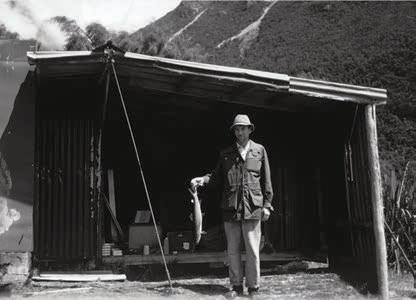

After marrying in 1946, Marr and Dinora travelled to Cyprus with Bomberg. Painting there together Marr’s work flourished, and he would later describe his time in Greece as the point at which he achieved the ‘enlightened’ state. But with the break-up of the Borough Group in 1950 Marr turned to other interests, including as a photographer, film maker and Formula 1 driver before returning to painting after Bomberg’s death in 1957.
Re-connecting with Bomberg’s original approach, Marr travelled far and wide to seek out wild and isolated landscapes – as far afield as New Zealand - and used extreme contrasts and thrusting diagonals to depict untamed Nature. In the present sale these landscapes include Stiper Stones, Shropshire (lot 67); Scotland (lots 73 & 74) and Exmoor, Devon (lots 68 & 70) where he lived for a number of years. But Bomberg’s nervous energy can equally be seen in Marr’s charcoal of Venice (lot 69), which combines a massing of architectural elements with an unnerving air of instability. A later influence in Marr’s work was Chaim Soutine, as evident in the two still-lifes in the sale (lots 72 & 75).
26
LESLIE MARR (BRITISH 1922–2021)
RECLINING NUDE
signed Marr lower left; dated 19 Nov.’71 lower right watercolour

55 x 75cm; 21½ x 29½ in
77.5 x 98cm; 30½ x 38½in (framed)
£150–250 ARR may apply
67
LESLIE MARR (BRITISH 1922–2021)
THE STIPER STONES, SHROPSHIRE
signed and dated Marr ‘75 lower left; titled and dated 1975 on the reverse oil on canvas
71 x 91cm; 38 x 35¾in
88.5 x 108.5cm; 30 x 42¾in (framed)
Exhibited
London, Portland Gallery, Leslie Marr, A Centenary Exhibition, 2022, n.n.

£500–700 ARR may apply
68
LESLIE MARR (BRITISH 1922–2021)
EXMOOR, DEVON
signed and dated Marr 21/8/04 lower left oil on canvas
64 x 76cm; 25¼ x 30in
£600–800 ARR may apply

66
27 66 67 68
LESLIE MARR (BRITISH 1922–2021)
VENICE, THE GRAND CANAL AND THE ACCADEMIA BRIDGE

signed and dated Marr July ‘89 lower left
charcoal on paper
43 x 59.5cm; 17 x 23½in
75.5 x 90.5cm; 29½ x 35½in (framed)
Exhibited
Newcastle, Northumbria University Gallery, Leslie Marr, Into the 21st Century: Paintings, 2007, no. 45.
£100–150 ARR may apply
70
LESLIE MARR (BRITISH 1922–2021)
(I) EXMOOR-SUNSET; (II) EXMOOR IN THE RAIN
(i) signed and dated Marr.99 lower right;
(ii) signed and dated Marr./99 lower right
both: watercolour
(i) 13 x 17.5cm; 5 x 7in
36.5 x 40cm; 14¼ x 15¾in (mount; unframed)
(ii) 11.5 x 14.5cm; 4½ x 5¾in
29.5 x 31.5cm; 11¾ x 12½in (framed)
(2)
£150–250 ARR may apply
71
LESLIE MARR (BRITISH 1922–2021)
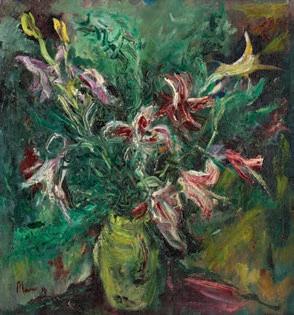
(I) MISTY DAWN, TUSCANY; (II) LANDSCAPE IN ANDALUCIA
(i) signed and dated Marr 8/91 lower left;
(ii) signed and dated Marr/3/07 lower left
both: watercolour


(i) 14.5 x 19.5cm; 5¾ x 7¾in
32.5 x 36.5cm; 12¾ x 14¼in (framed)
(ii) 13 x 18cm; 5 x 7in
31 x 35cm; 12¼ x 13¾in (framed)
(2)
£150–250 ARR may apply
69
28
72
69 70 (ii) 71 (i)
LESLIE MARR (BRITISH 1922–2021)
LILIES
signed and dated Marr ‘90 lower left oil on canvas
76 x 71cm; 30 x 28in
93 x 88cm; 36½ x 34½in (framed)
Exhibited
Newcastle, Northumbria University Gallery, Leslie Marr, Into the 21st Century: Paintings, 2007, no. 20
London, Portland Gallery, Leslie Marr: A Centenary Exhibition, 2022, n.n.
£500–700 ARR may apply
73
LESLIE
MARR
SCOTLAND
(BRITISH 1922–2021)
signed and dated Marr 60/08 lower left oil on canvas
102 x 127cm; 40 x 50in
£1,000–1,500 ARR may apply
74
LESLIE MARR (BRITISH 1922–2021)
HARRIS, SCOTLAND
signed and dated Marr ‘84 lower left oil on canvas
63 x 71cm; 24¾ x 28in
79 x 86.5cm; 31 x 34in (framed)
Exhibited
Newcastle, Northumbria University Gallery, Leslie Marr, Into the 21st Century: Paintings, 2007, no.17
London, Portland Gallery, Leslie Marr: A Centenary Exhibition, 2022, n.n.


£400–600 ARR may apply
75
LESLIE MARR (BRITISH 1922–2021)

STILL LIFE OF FLOWERS
signed and dated Marr. ‘71 lower left oil on canvas
63.5 x 76cm; 25 x 30in
£400–600 ARR may apply
72
29 73 74 75
LEO DAVY (LOTS 76–85)
There have been those who seem to have been artists, almost it appears from the day of their birth; such people are incapable of deviating from their natural and compulsive obsession in a world of their own, a world in which their lives are entirely consistent with their work and their being are one and the same thing. Leo Davy was one of these. (Sir Kyffin Williams, ‘Leo As I Knew Him’, in A Passion to Paint, Piano Nobile, (exhib. cat). London, 2010, p. 6.)
Born on Ilkley Moor, West Yorkshire, Davey was one of nine children. He refused to attend school with his siblings and instead was home schooled by his painter-art teacher father and musician mother. He became an accomplished artist and pianist early in his life and in his teens Davy entered one of his drawings into a National Newspaper Art Competition; he won and at the age of 14 enrolled in the Kingston School of Art under Reginald Brill. Unable to be conscripted due to his inherited deafness, in 1942 he started at the Slade which had been evacuated to Oxford during the Blitz. One of only a few male students and with a keen interest in philosophy, Davy often sneaked into the university to attend lectures and made many friends among the philosophy students. Art was for him a philosophical enquiry. It was at the Slade that Davy met Kyffin Williams who had been invalided out of the army. Both men later became teachers and settled for a while in Highgate. But Davy left teaching to concentrate on his art. Often described as an outsider or unconventional in his approach to life he communicated best through his work. His art was a very personal manifestation of himself - his maxim being ‘to paint as only I can paint.’ Determined not to make a living from his painting he worked as a toolmaker and tomato picker while living in an abandoned coastguard’s cottage in Lancing and later became an accomplished framer and gilder, firstly in London and then living on the North Cornwall coast with his wife Antonia. Davy spent most of his life surviving with very little money, moving from garret to garret in London - the archetypal bohemian artist. For the majority of his life he shied away from the art world and was hostile to showing his work. In fact, he rarely exhibited at all and sometimes turned down prospective purchasers for his deeply personal works. However, in 1950 Davy’s work was included in a summer show at Gimpel Fils alongside the pre-eminent artists of the day including William Gear, Victor Pasmore, Prunella Clough, Alan Davie and Patrick Heron. Having spent most of his life refusing to travel in his later life he did visit Paris twice with Antonia. He was mesmerised by the city. Davy died unexpectedly of a heart attack at his home in North Cornwall in 1987.


30
LEO DAVY (BRITISH 1924–1979)
DECONSTRUCTION
signed and dated LEO DAVY 48 lower centre
oil on canvas
43.5 x 34.5cm; 17 x 13½in (unframed)


Painted in 1948.
£600–800 ARR may apply
77
LEO DAVY (BRITISH 1924–1979)
HEAD oil on board
60 x 44.5cm; 23½ x 70½in
81.5 x 66cm; 32 x 26in (framed)
Painted in 1950.
£1,500–2,000 ARR may apply
78
LEO DAVY (BRITISH 1924–1979)

ORGANIC FORM
oil on board
59.5 x 30cm; 23¼ x 12in
76.5 x 46cm; 30 x 18in (framed)
Painted in 1953.
£2,000–3,000 ARR may apply
76
31 76 77 78
LEO DAVY (BRITISH 1924–1979)
UNTITLED
oil on board
50 x 29.5cm; 19¾ x 11½in
72 x 51cm; 28¼ x 20in (framed)
Painted in 1954.
£1,500–2,500 ARR may apply
80
LEO DAVY (BRITISH 1924–1979)
BLUE AND RED ABSTRAACT
oil on board
79 x 43cm; 31 x 17in

101 x 65.5cm; 39¾ x 25¾in (framed)
Painted in 1955.
£2,000–3,000 ARR may apply
81
LEO DAVY (BRITISH 1924–1979)
DECONSTRUCTION
oil on paper
75.5 x 62cm; 29¾ x 24½in
96 x 82cm; 37¾ x 32¼in (framed)
Painted in 1962

£2,000–3,000 ARR may apply

79
32
79
81
80
LEO DAVY (BRITISH 1924–1979)
ELEMENTS DU SANS HUMAIN
signed, titled, inscribed and dated Elements du sans humain/spirochetes
leucocytes polynucléaire!/LEO 54 oil on paper
50 x 76cm; 19¾ x 30in
71 x 95.5cm; 28 x 37½in
£1,500–2,500 ARR may apply
83
LEO DAVY (BRITISH 1924–1979)
UNTITLED
signed and dated 64/LEO DAVY lower right; signed and dated Leo Davy/ June/64 on the reverse oil on board
122 x 61cm; 48 x 24in (unframed)


Painted in 1963.

£1,200–1,800 ARR may apply
84
LEO DAVY (BRITISH 1924–1979)
HEAD oil on board
65.5 x 44.5cm; 25¾ x 17½in
86.5 x 64.5cm; 34 x 25¼in (framed)
Painted in 1973
£1,200–1,800 ARR may apply
85
LEO DAVY (BRITISH 1924–1979)

OUTSIDE: NEW BEGINNING
signed and dated LEO DAVY 78 upper right oil on board
80.5 x 74.5cm; 31¾ x 29¼in
101.5 x 96.5cm; 40 x 38in (framed)
Painted in 1978.
£1,500–2,000 ARR may apply
82
33 82 83 84 85
JAMES HULL (LOTS 86–97)
Hull aptly summed up his work as ‘a tension of objects in space’. And at his solo ‘come-back’ exhibition at Adrienne Resnick Gallery in 1989 Resnick described him as ‘a giant, both physically and as an artist’. Hull’s reputation flourished in the 1950s, when he established himself as one of the leading abstract painters of the post-War years in Britain. His first one-man exhibition was at the Brook Street Gallery in 1949 where Herbert Read gave the opening address. In 1951 he designed a mural for the Dome of Discovery at the Festival of Britain and started showing regularly with Gimpel Fils (1951–56). Elsewhere in London he exhibited with the Redfern Gallery and at the ICA and took part in the renowned This is Tomorrow exhibition at the Whitechapel Art Gallery in 1956; the same year Gimpel held a joint exhibition of Hull and Roger Hilton’s work (fig. 1). Abroad he showed with Galerie de France, Paris, Passedoit Gallery, New York (together with Peter Lanyon and William Gear), and at the Carnegie Institute, Pittsburgh.


But in 1960 Hull turned his back on painting after winning a competition to design the interior of the Daily Mirror building. He spent the next ten years as a full-time design consultant for the International Publishing Corporation (IPC), before moving with his family to Ibiza where he designed jewellery. After the tragic death of his daughter in a car accident in the early 1970s he left to embark on a solo travel odyssey. Over the next few years he held down a variety of jobs, including as a consultant designer for NASA’s space shuttle building in the USA. Returning to London in 1980 he took up painting once more. It took him a few years to re-establish himself, but by the end of the decade his work was starting to get traction once again, first at the Strickland Gallery in 1986, and then with Adrienne Resnick Gallery and Whitford & Hughes in 1989. His death a year later was all too premature.
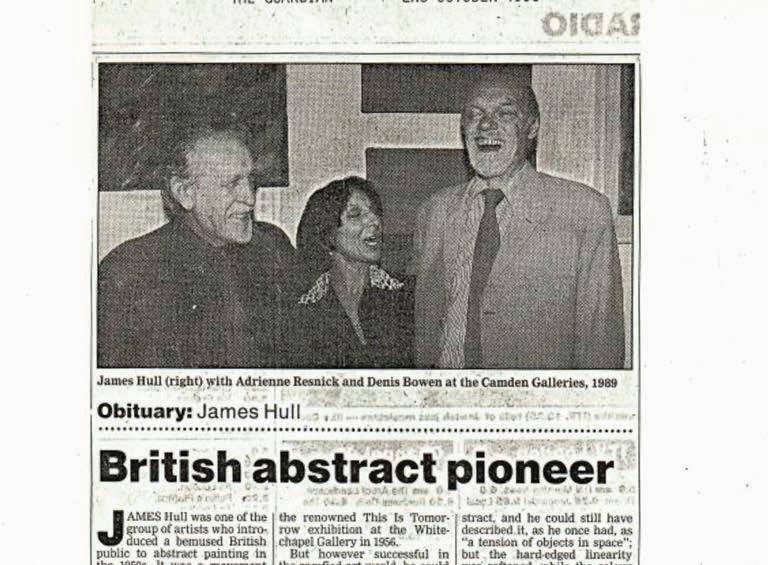
34
1
fig.
JAMES HULL (BRITISH 1921–1990)
COMPOSITION 54
signed and dated HULL 54 upper left
collage
23 x 52.5cm; 9 x 20¾in
40 x 70cm; 15¾ x 27½in (framed)
£300–500 ARR may apply
87
JAMES HULL (BRITISH 1921–1990)
PLAYGROUND
collage
21 x 44cm; 8¼ x 17¼in

39.5 x 62.5cm; 15½ x 24½in (framed)
Provenance:
with Gimpel Fils, London (titled on the label)
£300–500 ARR may apply
88
JAMES HULL (BRITISH 1921–1990)
COMPOSITION 90

signed and dated HULL III 90 upper left acrylic and mixed media on the artists prepared canvas board
54 x 78cm; 21¼ x 30¾in
62.5 x 88.5cm; 24½ x 34¾in (framed)
£500–700 ARR may apply
89
JAMES HULL (BRITISH 1921–1990)
COMPOSITION 84
signed and dated HULL V 84 lower left pencil and gouache on paper


56 x 76.5cm; 22 x 30in (unframed)
£400–600 ARR may apply
86
35 86 87 88 89
JAMES HULL (BRITISH 1921–1990)
COMPOSITION II 89
signed and dated HULL II 89 lower right
gouache and pastel on paper
64 x 45.5cm; 25¼ x 18in (unframed)
£400–600 ARR may apply
91
JAMES HULL (BRITISH 1921–1990)
COMPOSITION X 87
signed and dated HULL I X 87 lower left acrylic and watercolour on paper

55 x 78cm; 21¾ x 30¾in
69 x 92cm; 27 x 36¼in (framed)
Exhibited
London, Whitford and Hughes, Recent Works, 1989, no. 14.
£500–700 ARR may apply
92
JAMES HULL (BRITISH 1921–1990)
COMPOSITION V 86 (RECTO & VERSO)
signed and dated HULL V 86 upper left - recto pencil and gouache on paper
61 x 70; 24 x 27½in (unframed)
£500–700 ARR may apply
93
JAMES HULL (BRITISH 1921–1990)
COMPOSITION II 86
signed and dated HULL II 86 lower right; signed, titled and inscribed No 14/ MIXED/MEDIA/ON/PAPER/James Hull on a MoMart label on the reverse
acrylic, watercolour and crayon on paper
70 x 100cm; 27½ x 39¼in
74 x 103.5cm; 29 x 40¾in (framed)
Exhibited
London, Whitford and Hughes, Recent Works, 1989, no. 14.


£500–700 ARR may apply

90
36 90 91 92 93
JAMES HULL (BRITISH 1921–1990)
COMPOSITION X 84
signed and dated HULL X 84 lower right gouache on paper

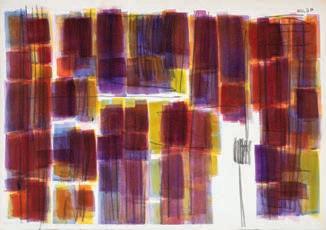
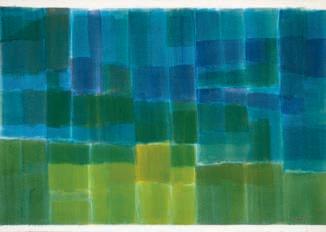
70.5 x 99.5cm; 27¾ x 39¼in (unframed)
£500–700 ARR may apply
95
JAMES HULL (BRITISH 1921–1990)
COMPOSITION IX 84
signed and dated HULL IX 84 upper right pencil and gouache on paper
70 x 99.5cm; 27½ x 39¼in (unframed)
£400–600 ARR may apply
96
JAMES HULL (BRITISH 1921–1990)
COMPOSITION VIII 84 (I)
signed and dated HULL VIII 84 upper right pencil and gouache on paper
70.5 x 99.5cm; 27¾ x 39¼in (unframed)

£500–700 ARR may apply
97
JAMES HULL (BRITISH 1921–1990)
COMPOSITION VIII 84 (II)
signed and dated HULL VIII 84 upper right pencil and gouache on paper
70.5 x 99.5cm; 29¾ x 39¼in (unframed)
£300–500 ARR may apply
94
37 94 95 96 97
BERNARD MYERS (1925–2007) (LOTS 98–123)
Some artists find that teaching interferes with their work. I find it clarifies my work. Trained as a gunner in the RAF during the Second World War, Bernard Myers studied at St Martin’s School of Art (1947–49) and Camberwell (1949–51) before studying painting at the Royal College of Art in 1951. Fellow students included John Bratby and Jack Smith, Frank Auerbach and Leon Kossoff.
After graduating ARCA in 1954, Myers taught, variously at Camberwell, Hammersmith and Ealing art schools, and was senior lecturer in drawing at the Architectural Association School. At the AAS he was talent-spotted to return to the RCA, where he spent the following two decades, punctuated in 1968 and 1971 by stints as Visiting Professor at the Indian Institute of technology, New Delhi. His final teaching post was as Chair of Design Technology at Brunel University (1979–85).


At the RCA students such as James Dyson treasured Myers’ good advice, remembering him as ‘cheerful, irrepressible [and] rather dapper… with a tweed suit and bowtie…’ But as well as being upbeat Myers was greatly appreciated for his considerable range of mind and intellect. And teaching left him free to practise his own art exactly as he wished. As he noted:
‘Some artists find that teaching interferes with their work. I find it clarifies my work.’ Indeed, he had an unstoppable compulsion to paint, incessantly exploring a wide range of subject matter, in particular the landscapes he encountered on his varied travels, the still-lifes he returned to again and again in his studio, the nudes he painted in weekly life-classes, and his not infrequent forays into abstraction, precipitated in part by his fascination with space.
He married Pamela Fildes, granddaughter of the painter Sir Luke Fildes in the early 1950s (lot 98); they lived first in Windsor and then in Kensington before moving in 1974 into one of the studios overlooking the Thames at St Peter’s Wharf, purpose built by Julian Trevelyan, next to Hammersmith Terrace (lots 121–123). He had several one-man shows in the West End, the first at the New Art Centre in 1969; his last with Austin Desmond Fine Art in 1991. He wrote two books on Goya, others on the history of sculpture and How to Look at Art, and co-edited The Macmillan Encyclopedia of Art’ (1979). He also penned articles for The Artist (May 1988) on his highly original approach to pastel (lots 110, 111, 113–117), and in Artists and Illustrators (1995) on his Venice views (lots 118 & 119).
38
BERNARD MYERS (1925–2007)
MISS PAMELA FILDES
signed, titled and dated on reverse Bernard Myers/Miss Pamela Fildes/1955–6 oil on canvas
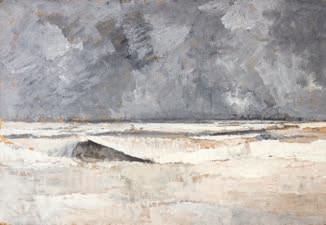

122 x 91.5cm; 48 x 36in (unframed)
Pamela Fildes was the granddaughter of the painter Sir Luke Fildes RA (1843–1927). She married Bernard Myers shortly after she sat for the present painting.
With the studio inventory number 0244 on the reverse.
£250–350 ARR may apply
99
BERNARD MYERS (1925–2007)
WAVES BENEATH A STORMY SKY oil on board
56 x 81cm; 22 x 32in
Painted in the 1950s.
With the studio inventory number 0290 on the reverse.
£200–300 ARR may apply
100
BERNARD MYERS (1925–2007)
PORTRAIT OF A SEATED MAN oil on canvas

76 x 50.5cm; 30 x 20in (unframed)
Painted in the 1950s.
With the studio inventory number 0267 on the reverse.
£200–300 ARR may apply
101
BERNARD MYERS (1925–2007)
TREES BY A LAKE oil on board
38 x 63.5cm; 15 x 25in (unframed)
Painted in the 1950s.

With the studio inventory number 0247 on the reverse.
£120–180 ARR may apply
98
39 98 99 100 101
BERNARD MYERS (1925–2007)
A CLOUDY SKY OVER MARSHLAND oil on board

63.5cm x 76; 25 x 30in (unframed)
Painted in the 1950s.
With the studio inventory number 0291 on the reverse.
£120–180 ARR may apply
103
BERNARD MYERS (1925–2007)
SAILING BARGES ON THE THAMES oil on canvas

30.5 x 40.5cm; 12 x 16in (unframed)
Painted in the 1950s.
With the studio inventory number 0387 on the reverse.
£60–80 ARR may apply
104
BERNARD MYERS (1925–2007)
CHURCH SPIRE THROUGH TREES oil on canvasboard

45.5 x 55.5; 17¾ x 21¾in (unframed)
Painted in the 1950s.
With the studio inventory number 0283 on the reverse.
£80–120 ARR may apply
105
BERNARD MYERS (1925–2007)
STILL LIFE OF FLOWERS IN A JUG signed with the initials lower right oil on canvas

30.5 x 25.5cm; 12 x 10in (unframed)
Painted in the 1950s.
With the studio inventory number 0384 on the reverse.
£60–80 ARR may apply
102
40 102 103 104 105
BERNARD MYERS (1925–2007)
TWO RECLINING NUDES

both: signed B MYERS on the reverse oil on card
(i) 23 x 15.5cm; 9 x 6in
(ii) 15.5 x 23cm; 6 x 9in (unframed) (2)
£80–120 ARR may apply
107
BERNARD MYERS (1925–2007)
STANDING FEMALE NUDES - A PAIR
both: signed B MYERS on the reverse oil pastel
both: 25 x 18cm; 9¾ x 7in
both: 29.5 x 21cm; 11½ x 8¼in (sheet) (unframed) (2)
£80–120 ARR may apply
108
BERNARD MYERS (1925–2007)
SEATED NUDES - A PAIR



both: signed B MYERS on reverse oil pastel

(i) 19.5 x 20.5cm; 7¾ x 8in
(ii): 25 x 19.5cm; 9¾ x 7¾in
both: 29.5 x 21cm; 11½ x 8¼in (sheet) (unframed) (2)
£80–120 ARR may apply
109
BERNARD MYERS (1925–2007)
SEVEN SKETCH BOOKS, DEPICTING EARLY VIEWS OF LONDON, COSTUME DESIGNS, VIEWS ACROSS PARIS, ITALY, COASTAL AND BOATING SCENES, HORSES, STILL LIVES, NUDES AND COLLAGE IDEAS
pencil, pen and brush and ink
15.5 x 23.5cm; 6¼ x 9¼in (largest)
13 x 9cm; 5 x 3½in (smallest)
(7)
Together with a quantity of the artist's drawing boards and miscellaneous items from the artist's studio, including two glass fruit bowls on stands, a quantity of shells etc.
£150–250 ARR may apply

106
41 106 107 108 109
BERNARD MYERS (1925–2007)
STILL LIFE WITH JAR, FRUIT AND FLOWERS signed B Myers lower right pastel

51.5 x 71cm; 20¼ x 28in (unframed)

With the studio inventory number 1067 on the reverse.
£200–300 ARR may apply
111
BERNARD MYERS (1925–2007)
STILL LIFE WITH APPLES ON RED signed B Myers lower right pastel

51 x 69.5cm; 20 x 27½in
66 x 84cm; 26 x 33in (framed)
With the studio inventory number 0328 on the reverse.
£200–300 ARR may apply
112
BERNARD MYERS (1925–2007)
STILL LIVES WITH FRUIT - A PAIR
both: signed with initials; both signed B MYERS on reverse oil on card
29 x 39cm; 11¼ x 15¼in (unframed)
(2)
£150–250 ARR may apply
113
BERNARD MYERS (1925–2007)
(I) BLUE ANEMONIES; (II) RED FLOWERS IN A VASE - A PAIR


(i) signed B MYERS lower right; (ii) signed with initials lower left oil pastel
34.5 x 24cm; 13½ x 9½in
48 x 36cm; 18¾ x 14¼in (mount)
(2)
With the studio inventory numbers 0688 and 0689 on the reverse.
£120–180 ARR may apply
110
42 110 111 112 113
BERNARD MYERS (1925–2007)
RED POPPIES IN A VASE - A PAIR

both signed B MYERS lower right pastel
(i) 35 x 24cm; 13¾ x 9½in (unframed)
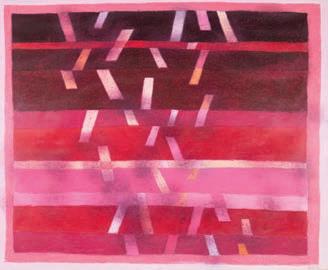
(2)
With the studio inventory numbers 0681 and 0692 on the reverse.
£120–180 ARR may apply
115
BERNARD MYERS (1925–2007)
UNTITLED (BLUE AND GREY)



signed with the initials and dated 74 lower right pastel
52.5 x 72cm; 20½ x 28¼in
62.5 x 85.5cm; 24½ x 33¾in (framed)
With the studio inventory number 0222 on the reverse.
£80–120 ARR may apply
116
BERNARD MYERS (1925–2007)
JOUR DE FÊTE
signed with initials and dated 74 lower right pastel
57 x 69.5cm; 22½ x 27½in
64 x 83cm; 25¼ x 32¾ (framed)
With the studio inventory number 0221 on the reverse.
£80–120 ARR may apply
117
BERNARD MYERS (1925–2007)
BLUE CASCADE
signed with the initials and dated 73 lower right pastel
51 x 73.5cm; 20 x 28¾ in
68.5 x 89cm; 27 x 35in (framed)
With the studio inventory number 0123 on the reverse
£80–120 ARR may apply
114
43 114 115 116 117
BERNARD MYERS (1925–2007)
VENICE PIAZZITTA IN A FLOOD, SAN MARCO
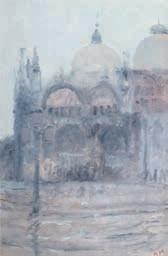

singed with the intials lower right; signed and titled Bernard Myers/Venice/ Piazitta in a flood/S. Marco on the reverse
52.5 x 73cm; 20¾ x 28¾in (unframed)
With the studio inventory number 0634 on the reverse.
£200–300 ARR may apply
119
BERNARD MYERS (1925–2007)
ST MARKS, VENICE
signed with the initials lower right oil on paper
51.5 x 34cm; 20¼ x 13¼in
58.5 x 41cm; 23 x 16in (framed)
With the studio inventory number 0325 on the reverse.
£100–150 ARR may apply
120
BERNARD MYERS (1925–2007)
(I) SOLDIERS WITH HORSES; (II) STUDY OF A CONCH SHELL oil on canvas

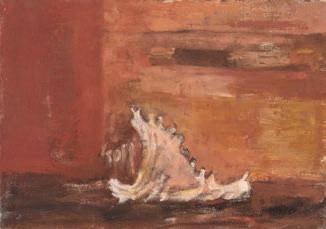
(i) 30.5 x 35.5 cm; 12 x 14in
(ii) 35.5 x 25; 14 x 10in (unframed)
(2)
With the studio inventory numbers 0392 (i) and 0393 (ii) on the reverse.
£150–250 ARR may apply
118
44 118 119 120
120
(i)
(ii)
BERNARD MYERS (1925–2007)
DINGY SAILING BY BARNES BRIDGE
signed with initials lower right oil on canvas
75 x 55cm; 29½ x 21¾in (unframed)
With the studio inventory number 0469 on the reverse.
£200–300 ARR may apply
122
BERNARD MYERS (1925–2007)
SCULLERS ON THE THAMES
signed with initials lower right; signed Bernard Myers on reverse oil on canvas
55 x 75cm; 21¾ x 29½in (unframed)
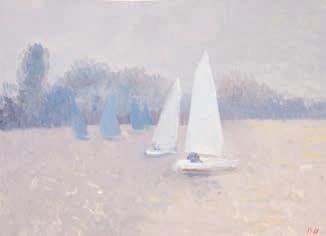


With the studio inventory number 0555 on the reverse.
£150–250 ARR may apply
123
BERNARD MYERS 1925–2007)
DINGY SAILING ON THE THAMES
signed with initials lower right oil on paper
52.5 x 73cm; 20½ x 28¾in (unframed)
With the studio inventory number 0456 on the reverse.
£200–300 ARR may apply
121
45 121 122 123
ALAN THORNHILL (LOTS 124–135)
Deliberately devoid of ‘initial idea’ my work is propelled by the process of improvisation. It evolves as an act of faith from an abstract into a figurative or at least an organic statement in accord with my general aspiration: to arrive by an uncharted route at images which strike home.

Thornhill grew up in Fittleworth, West Sussex and was educated at Radley and New College, Oxford where he read History. During the War he served as an officer in the Gloucestershire Regiment, and took part in the D-Day Landings, but after the bombing of Dresden by the Allies he became a conscientious objector.
After the War, Thornhill enrolled at Camberwell School of Art where he specialised in ceramics, and then spent a year at Farnham School of Art. In 1951 he set up Hawkley Pottery near Stroud and taught at Stroud School of Art. He sold his pots in Heal’s and was selected for the Council of Industrial Design’s Index of Good Design. But with his interest in potting waning he began to explore the sculptural possibilities that clay offered, encouraged by friends Lynn Chadwick and Jack Greaves. In 1959, on being offered a teaching post at Kingston School of Art, he set up a new studio in Putney.
Describing his work, his daughter Anna Thornhill wrote: [he] ‘pioneered a radical and improvisatory approach to clay work that involved dispensing with an internal armature and allowing content to emerge from his unconscious. Abstract pieces of the 1960s developed into large groups of figures. Pacifism, Jungian psychology and world conflicts were themes that emerged organically in his work.’ (The Guardian, 1 May 2020). With his fascination for the articulation of mass, his sculptural output ranged from portrait heads of leading figures from the arts, education and politics (such as the playwright Tom Stoppard, lot 125), to a series of monumental life-sized figurative compositions that evolved from his imagination during the 1970s and 1980s. Nine of his large-scale works form the Putney Sculpture Trail. One of these larger-scale works is included in this sale (lot 127).
Thornhill had several one-man shows, including at the Drian Gallery, Marble Arch; The National Theatre, South Bank; the Orangery, Holland Park; Putney Exchange; St Catherine’s College, Oxford; Kingscote Park, Gloucestershire and Galerie Jean Camion, Paris. In 2012 there was a major retrospective of his work at the Museum in the Park, Stroud.

46
ALAN THORNHILL (BRITISH 1921–2020) UNDERGROUND
aluminium relief

31 x 54.5cm; 12 x 20¼in
Conceived in 1961; cast in an edition of 6.
£500–700 ARR may apply
125
ALAN
THORNHILL
TOM STOPPARD
numbered 220 on neck
patinated terracotta
height: 43cm; 17in
(BRITISH 1921–2020)
Stoppard sat for this bust in 1973, a year after his play Jumpers had won the Evening Standard Award for Best Play and London Theatre Critics Award for Best New Play.

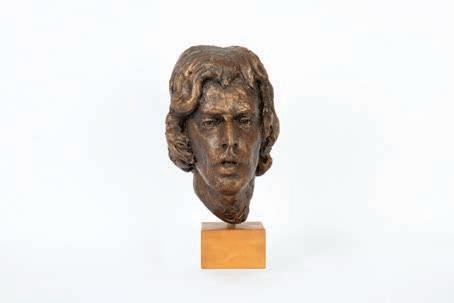
Thornhill was a great fan of Stoppard's work. He recalled of the present bust: 'Dissatisfied with the first day's attempt I did another in one day and felt I had made a breakthrough'. A bronze cast of the present work is in the Harry Ransom Center at the University of Texas (Austin) which has an extensive holding of Stoppard's papers.
Stoppard was born Tomáš Sträussler in Czechoslovakia in 1937. When the Nazis invaded the country in 1939 the Sträussler family fled to Asia. After the death of his father in Singapore his mother married Major Kenneth Stoppard, and after the War the family resettled in England. Stoppard worked first as a journalist, then as a theatre critic. His major break-through as a playwright was with Rosencrantz and Guildenstern are Dead, in 1966. Acclaimed plays have followed, amongst them The Real Inspector Hound (1968), Jumpers (1972), Travesties (1975), Arcadia (1993), and Leopoldstadt (2020).
£300–500 ARR may apply
126
ALAN THORNHILL
AUGURY
patinated terracotta
length: 73cm; 28¾in
height: 25.5cm; 10in
(BRITISH 1921–2020)
Executed in the 1970s, this terracotta is unique.
£300–500 ARR may apply
127
ALAN THORNHILL
LISTENER
patinated terracotta
height: 29cm; 11½in
(BRITISH 1921–2020)
Executed in 1984, this work is unique.
£250–350 ARR may apply

124
47 124 125 126 127
ALAN THORNHILL (BRITISH 1921–2020)
SELF-PORTRAIT
charcoal
61 x 44cm; 24 x 17¼in
65 x 48cm; 25½ x19in (framed)
£100–150 ARR may apply
129
ALAN THORNHILL (BRITISH 1921–2020)
CLOWNS - A PAIR
both: signed with monogram lower right charcoal
each: 40 x 29cm; 15¾ x 11½2in
each: 59.5 x 47cm; 23½ x 18½in (framed) (2)
£100–150 ARR may apply
130
ALAN THORNHILL (BRITISH 1921–2020)
DANCING FIGURES

signed and dated Alan Thornhill ‘84 lower right charcoal



56 x 58.5cm; 22 x 23in
74.5 x 77cm; 29¼ x 30¼in (framed)
£80–120 ARR may apply
131
ALAN THORNHILL (BRITISH 1921–2020)
TRIPLE CLOWN
signed Alan Thornhill lower right; titled Triple Clown lower left charcoal
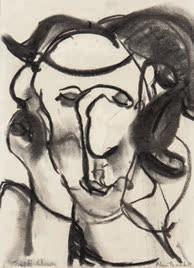
40 x 29cm; 15¾ x 11½in
59.5 x 47cm; 23½ x 29in (framed)
£60–80 ARR may apply
128
48 128 129 130 131
ALAN THORNHILL (BRITISH 1921–2020) SOLITARY
numbered A40 at one end
patinated terracotta
height: 23cm; 9in
length: 68cm; 26¾in
Executed in the 1970s, this terracotta is unique.



£150–250 ARR may apply
133
ALAN THORNHILL (BRITISH 1921–2020) SLEEP OF CLOWNS
terracotta
height: 34cm; 13½in
Executed in 1985, this work is unique.
£100–150 ARR may apply
134
ALAN THORNHILL (BRITISH 1921–2020)
NEXUS
clay
height: 146cm; 57½in
Executed in 1984, this work is unique. The bronze cast of the present work stands on the southside of Wandsworth Park, Putney and is one of the nine sculptures by Thornhill on the Putney Sculpture Trail.
The Putney Sculpture Trail was opened in 2008. Set by the Thames, the route runs for one and a half miles, from Leaders Gardens to the west of Putney Bridge to Point Pleasant to its east. The idea of the trail began with the donation of Thornhill's work Load to Wandsworth Council in the late 1980s installed close to Putney Bridge. In 2005 Thornhill offered further sculptures, and the idea of a sculpture trail along the banks of the Thames was devised, with primary sponsorship for the project from Western Riverside Environmental Fund and Wandsworth Council. It is now the largest permanent outdoor sculpture collection by one artist in London.
£300–500 ARR may apply
Please note that this work is located off-site. For pre-sale viewing please contact the department.
135
ALAN THORNHILL (BRITISH 1921–2020)
MASK
cast concrete
height: 34cm; 13½in

Executed in 1990, this work is unique.
£150–250 ARR may apply
132
49 132 133 134 135
HUGH CRONYN (LOTS 136–147)
Young, impressionable and fresh from Toronto where he had studied with the Group of Seven painter Frank Johnston, Cronyn departed Canada with an irrepressible can-do New World outlook. His unpublished memoirs recount his pre-war years: his time at the Arts Students League in New York in 1929; the early 1930s in Paris tutored by Jean Despujols and André Lhote; bicycling across the Alps; and on his arrival England his immersion into the rich bohemian life of West London.

From the mid-thirties he rented various studios by the Thames in Hammersmith and met many of the leading artists and writers of the day. One such was Ivon Hitchens, whose second solo exhibition at the Lefevre Gallery he helped hang. But most influential in his circle of friends was the critic, humourist and politician A P Herbert (‘APH’) and his wife Gwen, herself a painter and stage-designer of note. The Herberts were regulars at the Black Lion pub (lots 141 & 142). At their home at 12 Hammersmith Terrace, Cronyn met the likes of Edward Wadsworth, Mark Gertler, Leon Underwood and John Piper. Ceri Richards lived nearby, as did poets Robert Graves and Laura Riding in St Peter’s Square. He went on painting trips to Dorset with Julian Trevelyan, his neighbour at Durham Wharf, and to the French-Spanish border with Ray Coxon and Edna Ginese at the time of the Spanish Civil War.

After the outbreak of the Second World War, Cronyn was commissioned into the Royal Navy. Put in charge of the Naval bomb disposal squad in Bristol dockyards, he was the first Canadian to be awarded the George Medal (GM). In 1942 he married Jean Harris and settled in Suffolk where from 1949-69 he was tutor of painting at Colchester School of Art teaching alongside John Nash, Edward Bawden, Carel Weight and Peter Coker.
From 1963 the Cronyns began to spend their summers in Quercy, in the Lot, first renting a 15th century gatehouse and studio, then a small house, Les Vergers, before buying a dilapidated farmhouse in 1970 in Caufour which they renovated (lot 138).
From 1974 the Cronyns spent the winter months in 3 St Peter’s Wharf, next door to Hammersmith Terrace, in one of the artists’ studios overlooking the Thames constructed by Julian Trevelyan. Cronyn’s late paintings of the Thames, which capture the spectrum of colours as the seasons changed, document the river’s moods from winter mists to intense summer sun, and hang in many private collections (lots 146 & 147).
50
HUGH CRONYN (BRITISH 1905–1996)
VINEYARD, SAINT-REMY-DE-PROVENCE)
gouache
48 x 64cm; 18¾ x 25¼in
75.5 x 89.5cm; 29½ x 35¼in (framed)
Painted in the 1980s.
£300–500 ARR may apply
137
HUGH CRONYN (BRITISH 1905–1996)
CAUFOUR, STILL LIFE AND FIELDS oil on canvas
50.5 x 40.5cm; 19¾ x 16in (unframed)
Painted in the 1980s: view from the studio at Caufour, Rouillac in the Lot.


£200–300 ARR may apply
138
HUGH CRONYN (BRITISH 1905–1996)
CAUFOUR, BEFORE RESTORATION
signed and dated HUGH CRONYN ‘64 lower right gouche and pastel over pencil
41.5 x 53cm; 16½ x 21in
44.4 x 56cm; 17½ x 22in (framed)
£100–150 ARR may apply
139
HUGH CRONYN (BRITISH 1905–1996)
HARVEST ON THE CAUSSE
signed with the initials lower right oil on canvas
61 x 102cm; 24 x 40¼in
73.5 x 114cm; 29 x 44¾in (framed)
Painted circa 1980: the causses, typical of South West France, are limestone plateaus that are often farmed.


Exhibited:
Highgate Fine Art, early-1980s.
£500–700 ARR may apply
136
51 136 137 138 139
HUGH CRONYN (BRITISH 1905–1996)
SELF-PORTRAIT

signed HUGH CRONYN lower right oil on canvas
129 x 78.5 cm; 50¾ x 30¾in (unframed)
Painted circa 1960 in Adyar Studio, Flanders Road, Chiswick.
£300–500 ARR may apply
141
HUGH CRONYN (BRITISH 1905–1996)
BLACK LION SKITTLE ALLEY
signed, titled, numbered and dated 5/10, Black Lion skittle alley, Hugh Cronyn/36 lower margin


woodcut
13.5 x 17.5cm; 5¼ x 6¾in (plate size)
32.5 x 49cm; 12¾ x 19¼in (sheet) (unframed)
£150–250 ARR may apply
142
HUGH CRONYN (BRITISH 190–1996)
(I) THE OLD SHIP; (II) BLACK LION SALOON BAR
(i) signed, titled, numbered and dated 4/10, The Old Ship, Hugh Cronyn/1936 lower margin
14.7 x 10cm; 5¾ x 4in (plate size)
50 x 33cm; 19¾x 13in (sheet)
(ii) signed, titled, numbered and dated 9/10, BLACK LION SALOON BAR, HUGH CRONYN/36 lower margin
10 x 12.5cm; 4 x 5in
34 x 47.5cm; 13¾ x 18¾in (both unframed)
both woodcut
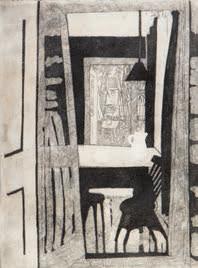
(2)
£200–300 ARR may apply
143
HUGH CRONYN (BRITISH 1905–1996)
INTERIOR, NAYLAND, SUFFOLK
signed, titled, inscribed and dated Artist’s proof, Interior, Hugh Cronyn/‘72 lower margin; stamped with the artist’s name and Hammersmith address on the backboard
etching
47 x 35cm; 18½ x 13¾in (plate)
78 x 57.5cm; 30¾ x 22¾in (framed)
£100–150 ARR may apply
140
52
140 141 142 (i) 143
HUGH CRONYN (BRITISH 1905–1996)
VETCH AND BARN

signed HUGH CRONYN lower right oil on canvas
27.5 x 37.5cm; 10¾ x 14¾in
42.5 x 53cm; 16¾ x 20¾in (framed)
Painted circa 1972, outside Peterbourgh, Ontario.
Exhibited:
London, Highgate Fine Art n.d.
£100–150 ARR may apply
145
HUGH CRONYN (BRITISH 1905–1996)
SCULL AND WAKE, THE THAMES
signed HUGH CRONYN lower right oil on canvas
50.5 x 61cm; 19¾ x 24in (unframed)
£400–600 ARR may apply
146
HUGH CRONYN (BRITISH 1905–1996)
SEAGULLS, THE THAMES
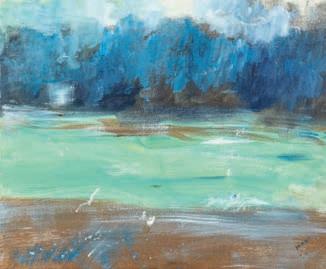

signed and dated HUGH CRONYN 69’ lower right oil on canvas
50.5 x 61.5cm; 19¾ x 24¼in
62.5 x 71.5cm; 24½ x 28¼in (framed)
£250–350 ARR may apply
147
HUGH CRONYN (BRITISH 1905–1996)

THE THAMES AT LOW WATER
signed HUGH CRONYN lower right oil on canvasboard
49 x 60.5cm; 19¼ x 23¾in
62.5 x 74 cm; 24½ x 29¼in (framed)
£250–350 ARR may apply
144
53 144 145 146 147


 This auction is conducted by Olympia Auctions in accordance with our Conditions of Business printed in the back of this catalogue.
This auction is conducted by Olympia Auctions in accordance with our Conditions of Business printed in the back of this catalogue.























































































































































































